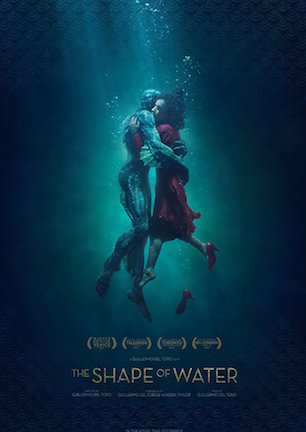The Shape of Water (Del Toro, 2017): USA
Reviewed byLarry Gleeson. Viewed at the Hitchcock Cinema and Public House.
 Leading the way in the 2018 Oscars race with a whopping thirteen nominations including Best Director and Best Motion Picture is Guillermo del Toro’s The Shape of Water, based loosely on the Universal Pictures 1954 sci-fi classic, The Creature from the Black Lagoon. Del Toro (Pan’s Labyrinth, Hellboy) wrote, directed and produced the film with a classical touch paying homage to 1950’s pop culture including a mid-film, stunning black and white ballroom dance sequence. Del Toro’s attention to detail allowed for a easy suspension of disbelief as the narrative followed a lonely, mute janitor who befriends an amphibious creature at a top secret research facility at the height of the Cold War.
Leading the way in the 2018 Oscars race with a whopping thirteen nominations including Best Director and Best Motion Picture is Guillermo del Toro’s The Shape of Water, based loosely on the Universal Pictures 1954 sci-fi classic, The Creature from the Black Lagoon. Del Toro (Pan’s Labyrinth, Hellboy) wrote, directed and produced the film with a classical touch paying homage to 1950’s pop culture including a mid-film, stunning black and white ballroom dance sequence. Del Toro’s attention to detail allowed for a easy suspension of disbelief as the narrative followed a lonely, mute janitor who befriends an amphibious creature at a top secret research facility at the height of the Cold War.
British actress, Sally Hawkins (Maudie, Blue Jasmine) portrays the mute, Elisa Esposito. Hawkins’ expressions and body language are quite convincing as her curiosity leads her to the creature, a mesmerizing, demi-god figure with expressive eyes and a physique reminiscent of the alien in the 1987 science fiction film, Predator. For her near-silent performance, Hawkins received one of the thirteen nominations associated with the film with a Best Performance by an Actress in a Leading Role. Doug Jones (Hellboy, Pan’s Labyrinth) portrays the Amphibian Man, most often referred to as “The Asset” by the U.S. military and its top secret research apparatus.
In its essence The Shape of Water is a full-fledged romantic fantasy. Frenchman Alexandre Desplat’s (The King’s Speech, Argo) musical score delights during the film’s fairy tale-esque opening and closing and augments the high emotional points of the film to a T. Desplat also shares in the film’s Oscar nods with a Best Achievement in Music Written for Motion Pictures (Original Score). But it’s Elisa’s ability to reach out and connect to the Amphibian Man through eggs and jazz music that drives the film on a more visceral and more human level. Who can’t relate to the power of finding connection? What makes this connection especially powerful, however, is not only the abuse the two lovers have endured prior to connecting, but it’s also important to note the film is set up against the “no prisoners taken,” “shoot first ask questions later,” Cold War between the United States and the former Soviet Union. Directives are given and orders are to be carried out. Or else.
Fortunately, Elisa only works there. But she’s not immune. While she’s a low-level “cleaning woman” who seems to enjoy hot baths, boiled eggs and exploring her sexuality (and not necessarily in that order either) as much if not more than her occupation, she does witness the Amphibian Man being abused. Surprisingly though she’s not alone as she has well-developed relationships with her co-worker, Zelda, portrayed by Octavia Spencer, and her neighbor, Giles, portrayed by Richard Jenkins. Both actors received Oscar nods for their performances with Spencer receiving a nod for Best Performance by an Actress in a Supporting Role and Jenkins getting a nod for Best Performance by an Actor in a Supporting Role.
Another dynamic deserving of attention is the exquisite and remarkable, metallic, aqua-marine color palette utilized in the film’s production design. Yes, the film received a nod for Best Achievement in Production Design for the team of Paul D. Austerberry, Shane Vieau and Jeffrey A. Melvin. Throughout the film, clips from 1950’s sit-coms are diagetically placed on set via television sets. Norman Vincent Peale’s best selling self-help book, “The Power of Positive Thinking,” is subtly intertwined in a conversation with Michael Shannon’s somewhat diabolical and altogether sadistic character, civilian Richard Strickland, who oversees and is charged with carrying out the US military’s research on the Amphibian man, and his superior to great affect.
I would feel amiss at this point if I didn’t mention the film’s Oscar nominations not previously noted: Best Original Screenplay for Del Toro and Vanessa Taylor; Best Achievement in Cinematography, Dan Laustsen; Best Achievement in Costume Design, Sequeira; Best Achievement in Sound Editing, Nathan Robitaille and Nelson Ferreira; Best Achievement in Sound Mixing, Christian T. Cooke, Glen Gauthier and Brad Zoern; and, Best Achievement in Film Editing, Sidney Wolinsky.
This is a wonderful film. Admittedly, it was my “early” (before Oscar nominations were announced) film of the year as I originally watched the film over the holidays with a date. Highly recommended!
About this entry
You’re currently reading “The Shape of Water (Del Toro, 2017): USA,” an entry on Student Film Reviews
- Published:
- 01.28.18 / 10pm
- Category:
- Films
52 Comments
Jump to comment form | comments rss [?]